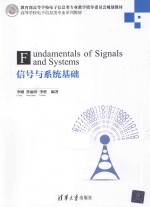图书介绍
信号与系统基础PDF|Epub|txt|kindle电子书版本网盘下载

- 李刚,常丽萍,李胜编著 著
- 出版社: 北京:清华大学出版社
- ISBN:9787302385981
- 出版时间:2015
- 标注页数:246页
- 文件大小:38MB
- 文件页数:259页
- 主题词:信号系统-高等学校-教材
PDF下载
下载说明
信号与系统基础PDF格式电子书版下载
下载的文件为RAR压缩包。需要使用解压软件进行解压得到PDF格式图书。建议使用BT下载工具Free Download Manager进行下载,简称FDM(免费,没有广告,支持多平台)。本站资源全部打包为BT种子。所以需要使用专业的BT下载软件进行下载。如BitComet qBittorrent uTorrent等BT下载工具。迅雷目前由于本站不是热门资源。不推荐使用!后期资源热门了。安装了迅雷也可以迅雷进行下载!
(文件页数 要大于 标注页数,上中下等多册电子书除外)
注意:本站所有压缩包均有解压码: 点击下载压缩包解压工具
图书目录
Chapter 1 Introduction1
1.1 Overview of signals and systems1
1.1.1 What is a signal?1
1.1.2 What is a system?2
1.2 Description and classification of signals5
1.2.1 Continuous-time signals and discrete-time signals6
1.2.2 Energy signals and power signals9
1.2.3 Periodic signals and non-periodic signals11
1.2.4 Deterministic signals and random signals14
1.2.5 Elementary signals15
1.3 Description of Systems22
1.3.1 Elementary systems22
1.3.2 System modelling26
1.4 Properties of systems29
1.4.1 Memoryless and with memory29
1.4.2 Causality30
1.4.3 Invertibility30
1.4.4 Stability31
1.4.5 Time-invariance33
1.4.6 Linearity34
1.5 Summary37
1.6 Problems37
Chapter 2 Time-domain Analysis of LTI Systems43
2.1 Introduction43
2.2 The unit impulse response and convolutions43
2.2.1 The convolution sum45
2.2.2 The convolution integral49
2.3 Properties of convolutions and equivalent systems51
2.4 Causality and stability of LTI systems56
2.5 Systems constrained with LCCDEs59
2.5.1 Continuous-time systems constrained with LCCDEs59
2.5.2 Discrete-time systems characterized by LCCDEs62
2.6 Summary64
2.7 Problems65
Chapter 3 Fourier Analysis of Signals69
3.1 Introduction69
3.2 Fourier series for continuous-time periodic signals70
3.3 Fourier series for discrete-time periodic signals80
3.4 Why should a signal be transformed?84
3.5 Fourier transform for continuous-time signals87
3.5.1 Properties of Fourier transform92
3.5.2 Inverse Fourier transform100
3.6 The discrete-time Fourier transform101
3.6.1 Properties of DTFT106
3.6.2 Inverse DTFT109
3.7 Fourier series and Fourier transforms110
3.8 Summary114
3.9 Problems115
Chapter 4 Frequency-domain Approach to LTI Systems121
4.1 Introduction121
4.2 Frequency response of LTI systems121
4.3 Bode plots for continuous-time LTI systems127
4.4 Frequency response of LTIs described with LCCDEs130
4.5 Frequency domain approach to system outputs135
4.6 Some typical LTI systems138
4.6.1 All-pass systems138
4.6.2 Linear phase response systems139
4.6.3 Ideal filters140
4.6.4 Ideal transmission channels143
4.7 Summary145
4.8 Problems146
Chapter 5 Discrete Processing of Analog Signals149
5.1 Introduction149
5.2 Sampling of a continuous-time signal150
5.3 Spectral relationship and sampling theorem150
5.4 Reconstruction of continuous-time signals154
5.5 Hybrid systems for discrete processing159
5.6 Discrete Fourier transform160
5.7 Compressed sensing164
5.8 Summary165
5.9 Problems166
Chapter 6 Transform-domain Approaches169
6.1 Motivation169
6.2 The Laplace transform169
6.2.1 Derivation of the transform169
6.2.2 Region of convergence171
6.2.3 Inverse Laplace transform176
6.2.4 Properties of Laplace transform178
6.3 The z-transform179
6.3.1 Region of convergence180
6.3.2 Properties of the z-transform184
6.3.3 Inverse z-transform186
6.4 Transform-domain approach to LTI systems187
6.4.1 Transfer function of LTI systems188
6.4.2 Inverse systems of LTIs and deconvolutions190
6.4.3 Revisit of LTI system's stability and causality192
6.4.4 Transfer function of LTI systems by LCCDEs195
6.5 Transform domain approach to LCCDEs197
6.6 Decomposition of LTI system responses200
6.7 Unilateral transforms202
6.7.1 Unilateral Laplace transform203
6.7.2 Unilateral z-transform205
6.8 Summary207
6.9 Problems207
Chapter 7 Structures and State-space Realizations212
7.1 Block-diagram representation212
7.2 Structures of LTIs with a rational transfer function214
7.3 State-space variable representation219
7.3.1 State model and state-space realizations219
7.3.2 Construction of an equivalent state-space realization221
7.3.3 Similarity transformations222
7.4 Discretizing a continuous-time state model224
7.5 Summary227
7.6 Problems228
Chapter 8 Comprehensive Problems231
8.1 Motivation231
8.2 Problems231
Appendices237
Bibliography246